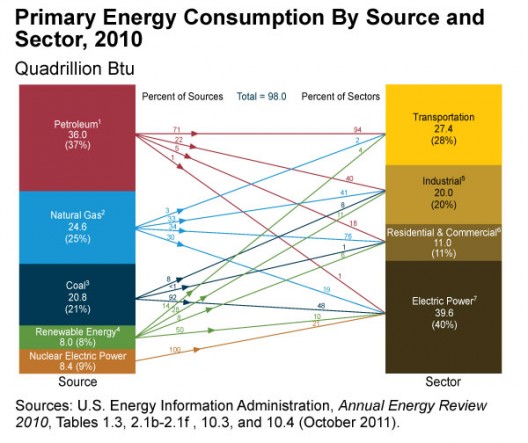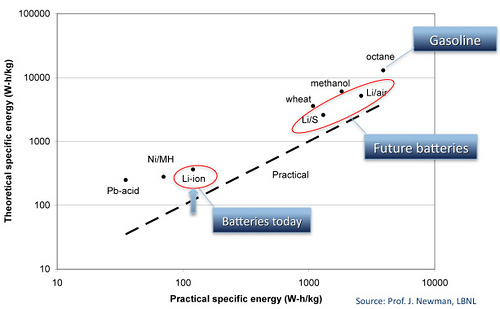$70,000 is a sizable base price for a car. That sum for the simplest of Tesla S sedans makes a bigger than average debt load for most of us, probably more than most can responsibly assume. Even the much anticipated model “E” at half that price is more stunning than the average sticker shock these days. What if, by some act of art or science, that $70,000 could be slashed to $14,000 for an electric vehicle that could travel 265 miles on a charge? That tall order is the order of the day for the Joint Center for Energy Storage Research, started two years ago under Dr. Steven Chu, who was then U. S. Secretary of Energy. He and his “teams” were charged with establishing the cooperative enterprise at “Argonne National Laboratory with a budget of $120 million over five years to create a battery five times more powerful and five times cheaper than today’s norms – all within five years.” We’re two years into the program – so how’s it going?
A lead article in The Seattle Times Monday morning removed any concern about progress, and the cooperative’s web site should alleviate any doubt that tax dollars are being spent wisely and well.
Not only would the price of EVs decline significantly if the group is successful, but the benefits would spill over into consumer products such as cellphones, laptops and the home-based “Internet of things.”
To pull of their ambitious goals, J-CESR’s researchers are delving into four lines of study:
- Electrochemical Storage Concepts looks at materials such as magnesium or yttrium (there’s a Scrabble winner) that carry twice or triple the charge of lithium, with two or three times the energy storage potential; chemical transformations that store many times the energy of today’s batteries; and non-aqueous redox flow that will be of great use in grid storage.
- “Crosscutting Science” that uses recently-developed research techniques to “make new materials and characterize their performance at the atomic level for the three energy storage concepts.
- “Systems Analysis and Translation designs virtual batteries on the computer, projects their performance, identifies shortcomings, and communicates results to the Science and Concept teams.” J-CESR is using high speed computers that will allow analysis at the femtosecond level (a quadrillionth of a second). They’re investigating new battery architectures “needed to leapfrog existing designs, improve system performance, raise cycle lifetimes and approach the theoretical energy and power densities of new materials and designs. New architectures will integrate novel materials and components at the nano- to macroscale.”
- As a grand capper, and the step ensuring taxpayers see a payoff for their investment, “Cell Design and Prototyping delivers pre-commercial prototypes for grid and transportation applications.”

Big numbers from big sources. What J-CESR will have to achieve to bring 100% clean energy to just the US
Getting Their Actors Together
Now spread out among its 14 academic and commercial members, key players will come together in a new Berkeley Hub with a $54 million, 43,000 square foot General Purpose Laboratory, “bringing its battery scientists, chemists and engineers together under one roof for the first time.”
Center Deputy Director Venkat Srinivasan will head the team, which aims to “achieve revolutionary advances in battery performance — creating devices with up to five times the energy capacity of today’s batteries at one-fifth the cost by 2017” – the same aims expressed by Energy Secretary Chu five years ago.
Srinvivasan explains, “We want to go beyond and find the next generation of technology. It’s clear to us that the batteries we have today are not meeting the needs.”
The Daily Californian reported Srinivasan’s remarks at the Center’s ribbon cutting. “You put a bunch of scientists and engineers together and they start interacting, and you have products coming out of the other end,” Srinivasan said. “They have very different skill sets, and so very new products … are the result.
Moving Beyond Lithium?
Elon Musk will soon compete, in a sense, not only against the Chevy Volt, BMW, Audi, Toyota and Nissan for primacy in the EV market, but will face researchers looking for the next big thing past lithium-ion batteries. The efforts of J-CESR point toward post-lithium developments. With others striving to perfect the delivery and distribution of hydrogen for vehicles, the market will soon provide choices that all lead to greener transportation.
J-CESR reports, “George Crabtree, director of the project at Argonne National Laboratory near Chicago, said the federal government is pursuing the research to transform the two areas that consume two-thirds of all the energy generated in the United States — transportation and the energy grid.”
“’There’s a real opportunity for next-generation storage,’ Crabtree said. ‘You have to make a big step forward. Lithium-ion will not be able to make that step. … You need a big program and a group effort to make it happen.’” He says researchers have narrowed things to about 100 chemistries, with a few in the prototype phase.
Berkeley’s battery research hub is next door to the Advanced Light Source building, where automaker Toyota has been researching magnesium-ion batteries, which promise double the charge of lithium at the same weight. That kind of potential charges up Srinivasan. “For the same weight, you can have twice the charge — you’re doubling the amount of capacity. That’s exciting.”
Sharing the lab will be principal investigator and Lawrence Berkeley staff scientist Brett Helms, focusing on the other charge for J-CESR, large-scale grid storage. Doubtless, discoveries within each group will be shared and expanded on.
Argonne National Laboratory leads JCESR in partnership with four other DOE national laboratories, five universities, and four private firms. Joining Argonne on the JCESR team are Lawrence Berkeley National Laboratory, Pacific Northwest National Laboratory, Sandia National Laboratories, and SLAC National Accelerator Laboratory. Participating universities include Northwestern University, the University of Chicago, the University of Illinois at Urbana-Champaign, the University of Illinois at Chicago, and the University of Michigan, and private firms joining the effort are Dow Chemical Co., Applied Materials, Inc., Johnson Controls Inc., and Clean Energy Trust.

